Geriatrics, Test Questions Exam 1 with complete solutions
Document Content and Description Below
Ch. 1: Which one of the following is most true about the rule of fourths? A. One fourth of geriatric problems are iatrogenic. B. Little can be done to prevent three fourths of the problems of agi... ng. C. For every medical complaint a patient has, a careful assessment can identify three other diagnoses. D. What use to be called normal aging can be largely explained by processes that are not normal. E. A good way to conduct a geriatric assessment is to use four categories: mental, physical, psycho-social, and environmental. - ANSWER D Ch. 1: Which one of the following is most TRUE about aging changes? A. Stage 3 and 4 sleep decreases. B. Renal perfusion is not reduced, but renal function is reduced. C. Hearing acuity declines beginning in middle age. D. Prostatic enlargement occurs only in a minority of men. - ANSWER A Ch. 1: An old woman who is care for by attentive, cautious, concerned family is particularly likely to suffer from which of the following complications after an episode of gastroenteritis? A. Immobility related to over-concern. B. Continued vomiting caused by too-rapid feeding. C. Diarrhea resulting from administration of milk products. D. Constipation related to over-treatment of diarrhea. - ANSWER A Ch. 1: Which one of the following is most TRUE about psychological aging? A. Disengagement tends to promote better psychological health than continued engagement. B. Having a spouse is the best way to be assured of having a caregiver when one becomes disabled. C. Ability to have quality of life is related to cognitive function. D. Planning for the future is a key element of successful aging. E. Many older people are ageist. - ANSWER E Ch. 1: Of the following conditions, which one is most common and most often preventable? A. Falls B. Frailty C. Cognitive impairment D. Iatrogenic disease E. Depression - ANSWER D Ch. 29: What is the hallmark of frailty in an aged patient? A. The patient is unable to personally manage key activities of self-care. B. The patient's reserve to withstand physiologic stress is significantly reduced. C. The patient has long problem and medication lists. - ANSWER B Ch. 29: Which pattern of problems would more likely identify a frail aged patient? A. She is unable to manage her own medications and her own wardrobe. B. She requires supplemental oxygen at night and during exercises. C. She walks very slowly, is losing weight, and does not have the strength to brush her own teeth. - ANSWER C Ch. 29: Having identified an aged patient as being irreversibly quite frail, the PCP would be wise to do which of the following? A. Begin a discussion with the patient and family about care goals and intervention limitations. B. Withdraw disease-targeting medications and medical treatments. C. Reduce functional maintenance modalities such as therapeutic exercise and activities. - ANSWER A Ch. 29: Each of these factors can help serve to identify a patient as frail and vulnerable except: A. Low activity level and easy fatigability B. Major progressing weight loss C. A large number of major organ-system co-morbidities D. Progressive loss of strength E. Very advanced age F. There is no "except" ... all are important factors in frailty. - ANSWER F Ch. 29: Progress has been made in defining a valid concept of frailty. Pick the one true statement about current understanding of the frailty syndrome. A. Neither of the Fried nor Rockwood model is well suited to frailty research B. Neither the Fried nor Rockwood model has found wide acceptance in the clinical care. C. The Fried model takes into account cognitive decline, pain, and chronologic age. D. Regardless of the models used to characterize it, frailty is a syndrome that rarely improve even with carefully tailored interventions. - ANSWER . B Ch. 29: Which of these statements about frailty is (are) true? A. The concepts of frailty and disability are essentially synonymous. B. Identifying a patient as "frail" can help guide thinking about risks and benefits in choosing care paths. C. Neither of the two most prominent models of frailty includes age as a factor. D. Frailty is typically irreversible, and when identified, primarily serves to initiate discussions regarding comfort care. - ANSWER B and C Ch. 29: All of the following concepts underlie the notion of"frailty in old age" EXCEPT: A. Progressive decline in organism reserves to be able to withstand a variety of stresses. B. Multiple interdependent organ systems progressing toward over failure with age and/or disease C. A well defined geriatric syndrome with a validated set of agreed-upon specific clinical markers. D. Higher risk for major untoward events with medical interventions that are generally safe in younger patients. - ANSWER C Ch. 4: The U.S Advisory Committee on Immunization Practices and the Center for Disease Control currently recommend that: A. All older adults be immunized against flu annually and that they receive at least one pneumococcal vaccination. B. All high-risk older adults should receive an additional pneumococcal vaccination 5 years or more after their first immunization. C. Older adults should receive a one-time re-vaccination for pneumonia if they were initially vaccinated more than 5 years previously and were less than 65 years of age at the time of the initial vaccination. D. All of the above - ANSWER D Ch. 4: Health care providers should recommend that older adults engage in: A. 150 minutes of moderate intensity physical activity weekly. B. 20 minutes of moderate intensity physical activity 3 days per week. C. 10 minutes of vigorous physical activity most days of the week. D. 30 minutes of vigorous physical activity 3 days per week. - ANSWER A Ch. 4: Guidelines for the primary prevention of stroke recommend that aspirin be used in: A. All individuals whose risk is high enough for the benefits to outweigh the risks. B. All individuals regardless of risk level C. All males regardless of risk level. D. All females who are also taking anti-hypertensives. - ANSWER A Ch. 4: Even though older adults are less likely to get counseled for smoking cessation, they have which of the following? A. The same quit rates as younger individuals. B. Approx. 50% better quit rates than younger individuals. C. Approx. 25% better quit rates than younger individuals. D. Much lower quit rates than younger individuals. - ANSWER A Ch. 36: All of these changes occur in patients older than age 65 with hypertension except: a. Increased peripheral resistance b. Decreased response to b-adrenergic stimulation c. Increasing diastolic blood pressure with age d. Decreased response to the renin-angiotensin system - ANSWER C Ch. 36: All of the following conditions are clearly risks of poorly controlled hypertension except: a. Stroke b. Myocardial infarction c. Congestive heart failure d. Renal failure e. Alzheimer's dementia - ANSWER E Ch. 36: An increased pulse pressure (the difference between systolic and diastolic blood pressure) in patients with hypertension: a. Is first seen in middle age then stabilizes b. Is associated with a better prognosis c. Is best treated with beta-blockers d. Is best treated with diuretics - ANSWER D Ch. 36: Which class of medications is the best-studied and most recommended first-line medication for treating hypertension in older patients without other compelling medical indications? a. Thiazide diuretics b. Alpha-blockers c. Beta-blockers d. Calcium channel blockers e. Angiotensin-converting enzyme (ACE) inhibitors - ANSWER A Ch. 36: The class of drugs important to use in patients with hypertension who also have congestive heart failure or renal failure is: a. Alpha-blockers b. Beta-blockers c. ACE inhibitors d. Calcium channel blockers - ANSWER C Ch. 37: Important risk factors for coronary artery disease (CAD) include all except which one of the following? a. Anemia b. Hypertension c. Diabetes mellitus d. Hyperlipidemia e. Age - ANSWER A Ch. 37: Lifestyle modifications useful in the treatment of CAD include all except which one of the following? a. Aerobic exercise b. Isometric exercise c. Reduction of stress d. Smoking cessation e. American Heart Association heart-healthy diet - ANSWER B Ch. 37: Sublingual nitroglycerin differs from isosorbide mononitrate given orally in which one of the following ways? a. Mechanism of relief of angina b. Effect on heart rate c. Duration of action d. Effect on postural blood pressure - ANSWER C Ch. 37: Unstable angina differs from stable angina in having which one of the following features? a. More numerous atherosclerotic plaques b. Atherosclerotic plaque located more proximally in the coronary arteries c. Greater association with an elevated platelet count d. Greater frequency and severity of anginal attacks e. More common in the elderly female than the elderly male - ANSWER D Ch. 38: Atypical manifestations of CHF in the elderly are most frequently related to reduced perfusion of which one of the following? a. Brain b. Heart c. Extremities d. Kidneys e. Lungs - ANSWER A Ch. 38: In patients with congestive heart failure, the best indicator of left ventricular systolic function is: a. Left ventricular ejection fraction (LVEF) b. Electrocardiogram c. Chest x-ray examination (CXR) d. Distended jugular veins e. Atrial fibrillation - ANSWER A Ch. 38: In patients with congestive heart failure, ACE inhibitors are contraindicated when which one of the following is present? a. Creatinine clearance 45 mL/min b. Blood urea nitrogen (BUN) 32 mg/dL c. Blood pressure 105/60 mmHg d. Serum potassium 5 mEq/L e. History of ACE inhibitor-induced angioedema - ANSWER E Ch. 38: The best way to differentiate between patients with systolic CHF and diastolic CHF is by: a. History b. Physical examination c. Echocardiography d. ECG e. Chest x-ray examination - ANSWER C Ch. 38: Beneficial effects of converting atrial fibrillation with heart rate of 120 beats per minute to sinus rhythm with heart rate of 80 beats per minute include all of the following except: a. Increased time for ventricular filling b. Restoration of atrial contributors to ventricular filling c. Decreased myocardial oxygen consumption d. Increased myocardial contractility e. Reduction in ventricular hypertrophy - ANSWER C Ch. 38: Which one of the following would be inconsistent with the onset of CHF in an elderly patient? a. Dyspnea b. Worsening ability to self-care c. Anorexia d. Falls e. None of the above - ANSWER E Ch. 21: Which of the following types of dizziness is most commonly reported by older persons? a. Vertigo b. Feeling of being about to pass out c. Disequilibrium d. Combination of two or more types of dizziness - ANSWER D Ch. 21: Which of the following is the least common cause of dizziness in primary care geriatrics? a. Anxiety b. Vertebrobasilar transient ischemic attacks c. An acoustic nerve tumor d. Cervical spine disease e. Cerumen against the tympanic membrane - ANSWER C Ch. 21: Which of the following historical or physical examination details would most effectively argue against benign paroxysmal positional vertigo as a cause of dizziness? a. Brief episodes of dizziness accompanied by nausea b. A negative result on Romberg's test c. Failure to reproduce the dizziness with Dix-Hallpike maneuver d. Episodes lasting 4 to 6 hours, with progressive unilateral hearing loss e. Multiple similar episodes over many years - ANSWER D Ch. 21: Ms. Smith is a 60-year-old woman who visited your office with complaints of sudden onset dizziness, and a feeling of spinning and wooziness for the last 1 to 2 weeks. She also complains of a feeling of ear fullness, tinnitus in her left ear, and fluctuating hearing loss. Dizziness spells usually last for a few hours. On examination, her vital signs are within normal limits. She has horizontal nystagmus. Her cardiac, respiratory, and neurologic examination is normal except she is not able to do a tandem walk and one-leg stand. Which of the following tests should be ordered next? a. Magnetic resonance imaging of the head b. Audiometery c. Computerized tomography of the head d. Electroencephalogram - ANSWER B Ch. 21: You are asked to evaluate an 80-year-old nursing home resident with past medical history of mild Alzheimer's disease, hypertension, and reflux esophagitis, who complains of feeling dizzy, a sensation of being about to pass [Show More]
Last updated: 2 years ago
Preview 1 out of 28 pages

Buy this document to get the full access instantly
Instant Download Access after purchase
Buy NowInstant download
We Accept:

Reviews( 0 )
$10.00
Can't find what you want? Try our AI powered Search
Document information
Connected school, study & course
About the document
Uploaded On
Aug 31, 2022
Number of pages
28
Written in
Additional information
This document has been written for:
Uploaded
Aug 31, 2022
Downloads
0
Views
41



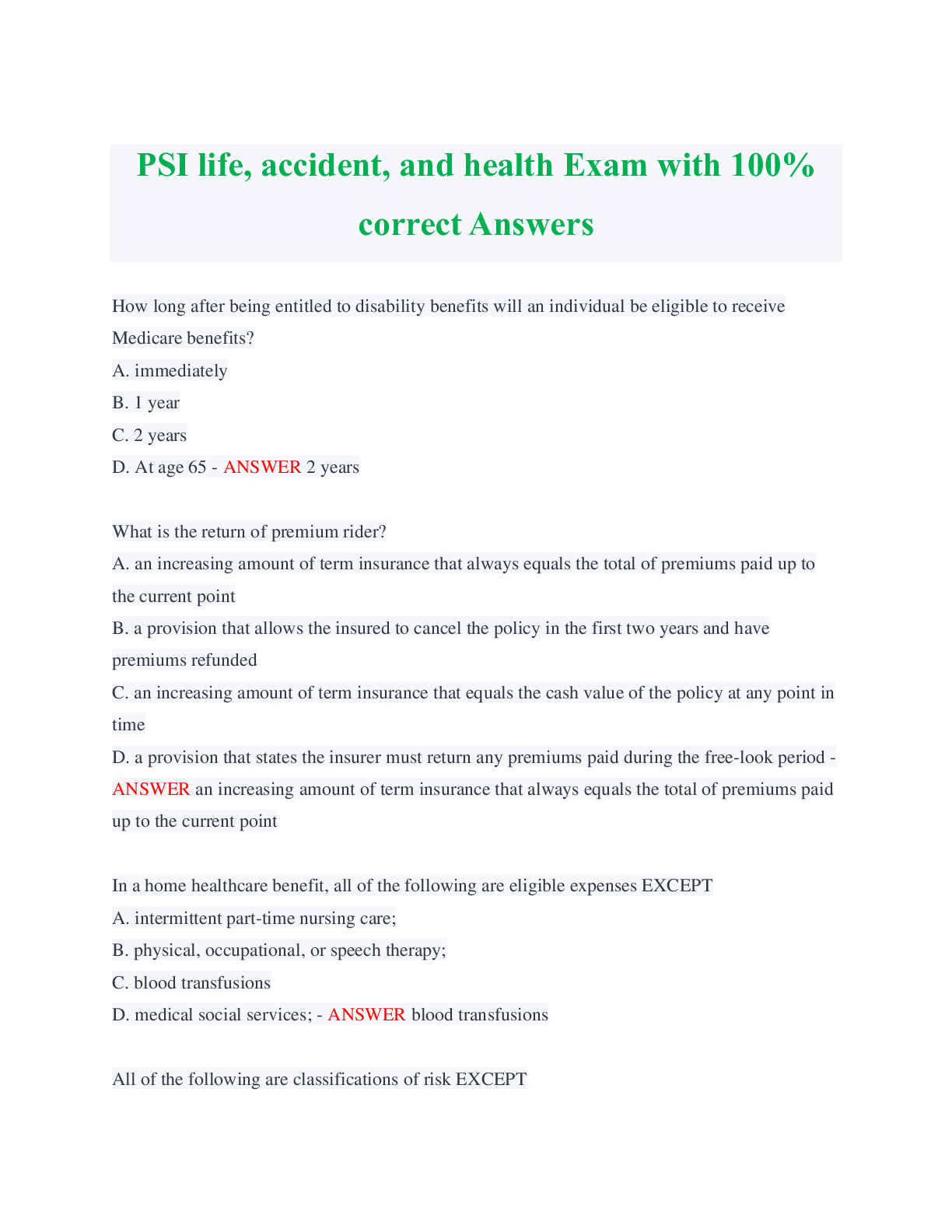









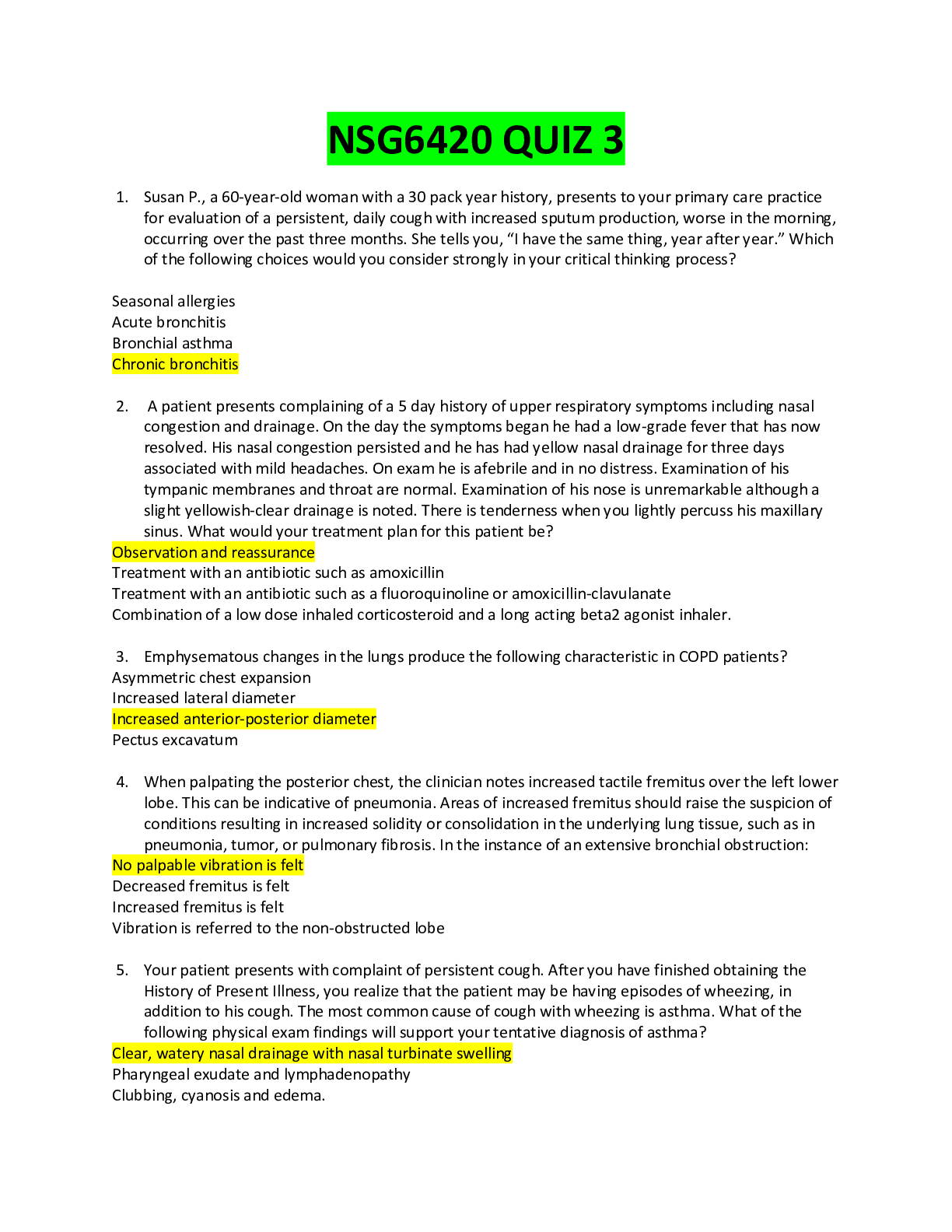
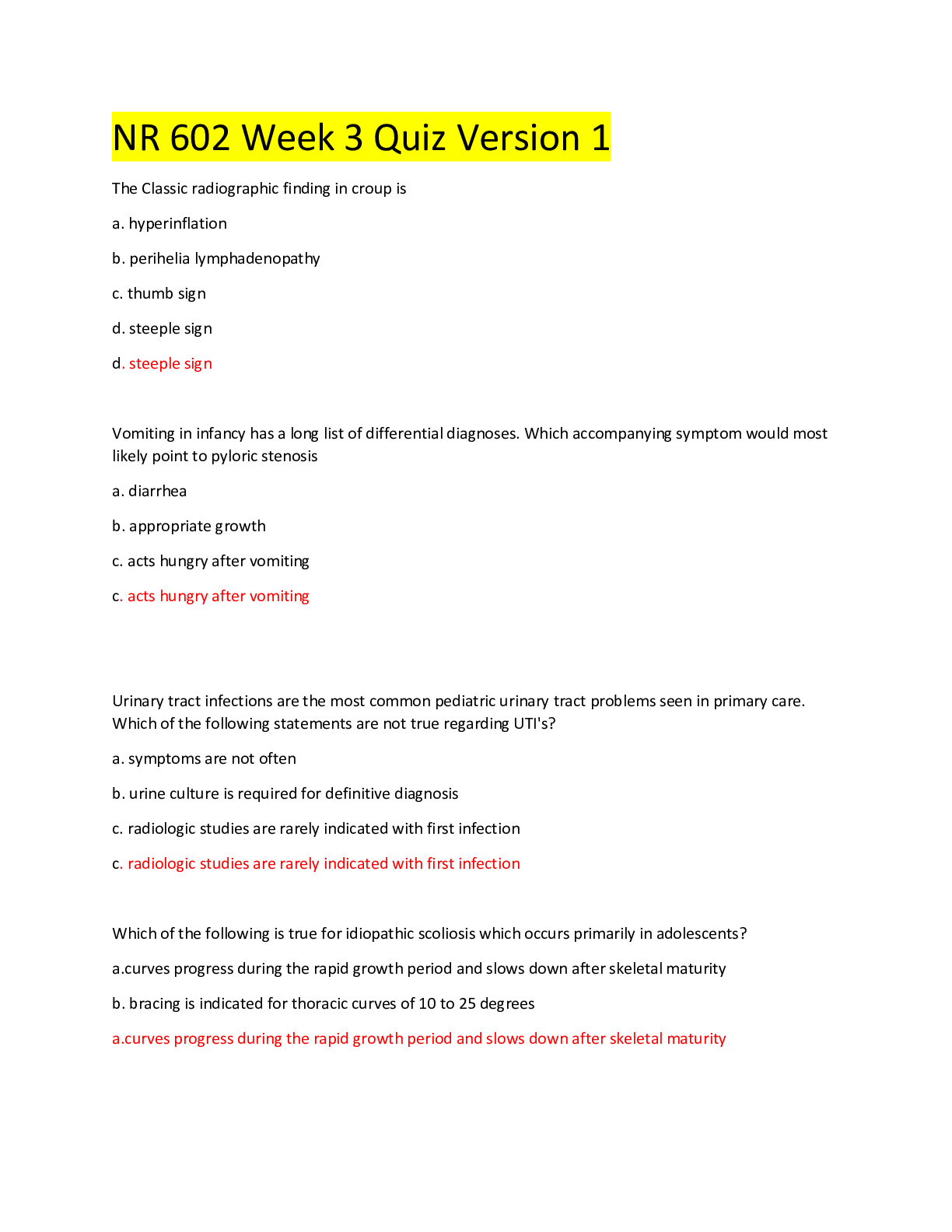
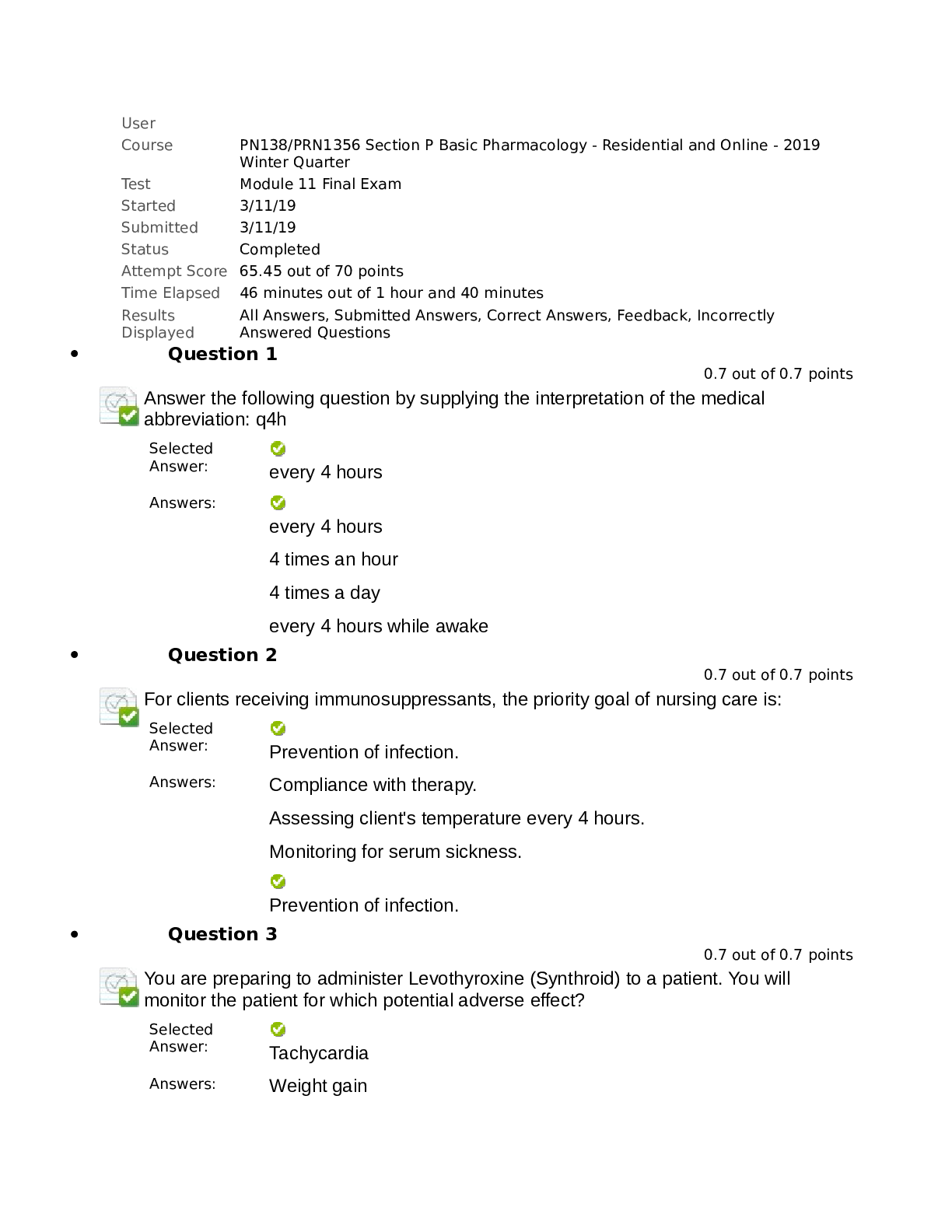
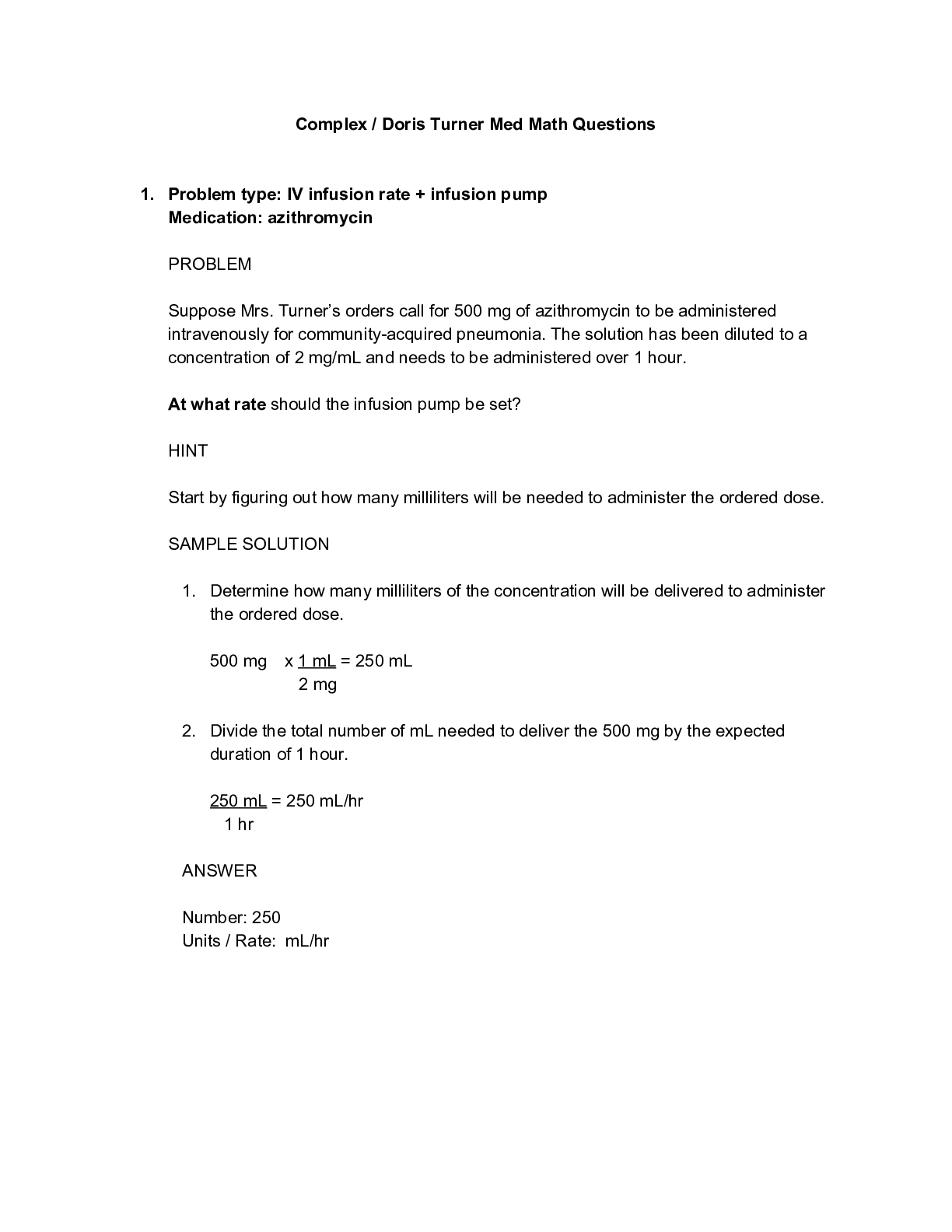






.png)

